Add some cottage vibes to your garden this summer by planting delphinium. A tall and elegant flower, they have the perfect combination of wildflower charm and ornamental vibrancy. Learn all about how to plant and take care of delphiniums with this guide.
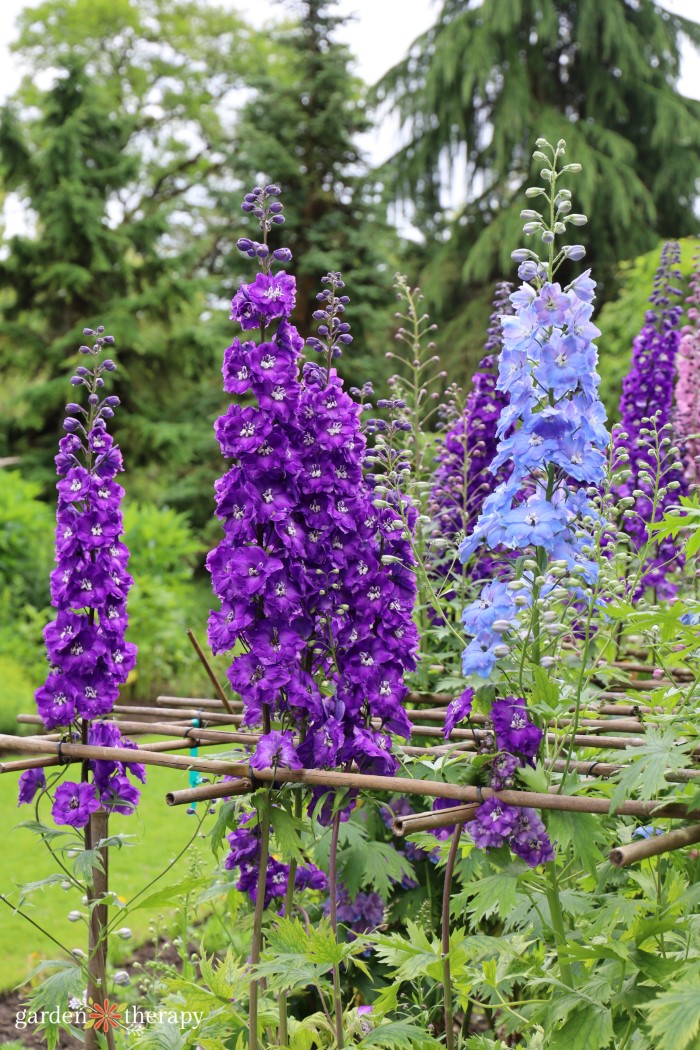
Looking to add some more colour to your summer garden? Well, delphinium will happily rise above the rest to provide some rare blue flower colour. Pollinators absolutely adore these flowers, with hummingbirds, bees, and butterflies stopping by to take a look.
An ornamental plant, delphiniums make for a good backdrop in the garden. They cut wonderfully, bringing some life indoors. They’ve been a staple for many years in perennial gardens, mine included!
If you’re not convinced already, read on for more beautiful delphinium photos to convince you otherwise!
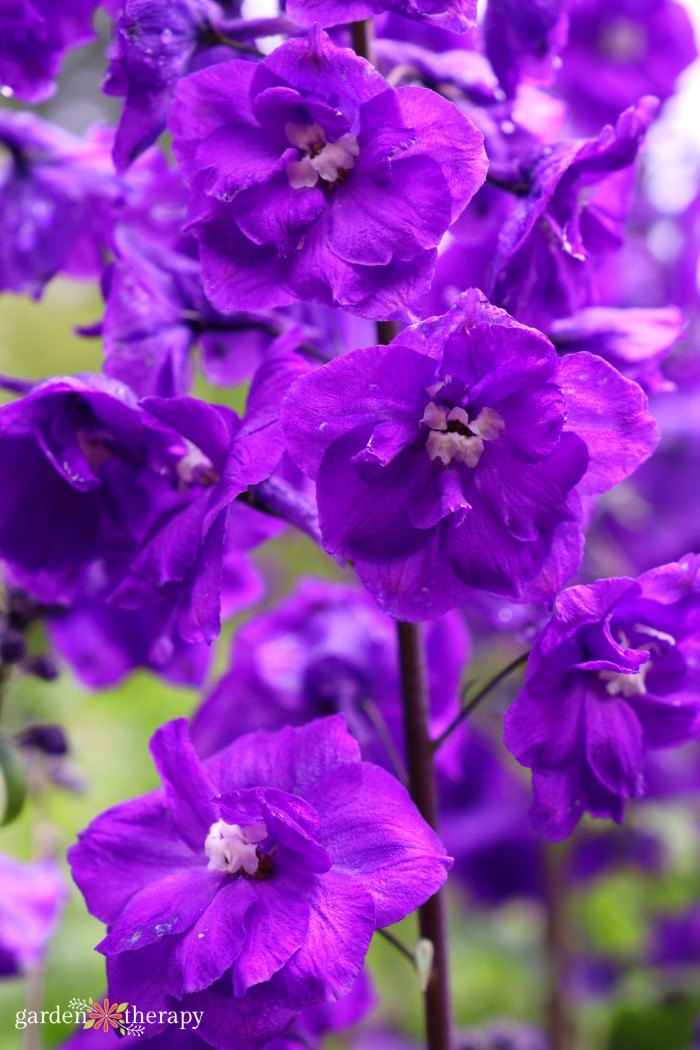

Delphinium Flower Profile
Delphinium is the scientific name for over 300 species from the family Ranunculaceae. The flower comes in blue, white, pink, and purple spikes of single or double flowers. Blue delphiniums are by far the most popular of the bunch, renowned for their rare true blue colour.
Delphinium flowers bloom in mid-summer and once again in late summer or early fall. They can be perennials, biennials, or annuals, but perennials are the most popular delphiniums in gardens. Most people refer to delphinium as a perennial flower, while others refer to larkspur as the annual flower (they’re in the same family, and larkspur is really a type of delphinium).
Native to the northern hemisphere, you can also find the flower in the high mountains of tropical Africa. They are named after the Greek word delphis, meaning dolphin, as the closed flower buds resemble the nose of the dolphin.
The delphinium flower represents love, joy, and cheerfulness, likely due to its bright blooms. It’s also the birth flower for July! You can find out more about blue flower symbolism here.
Delphinium Toxicity
Delphiniums are poisonous to both humans and animals. Avoid ingesting them at all costs, as it can cause digestion issues and serious discomfort. Some note that it causes skin irritation, so wear gloves when working with your delphinium. The plant is most toxic when young.
Those who raise livestock should take particular care as wild delphiniums are one of the main causes of cattle poisoning for ranchers in the western USA.
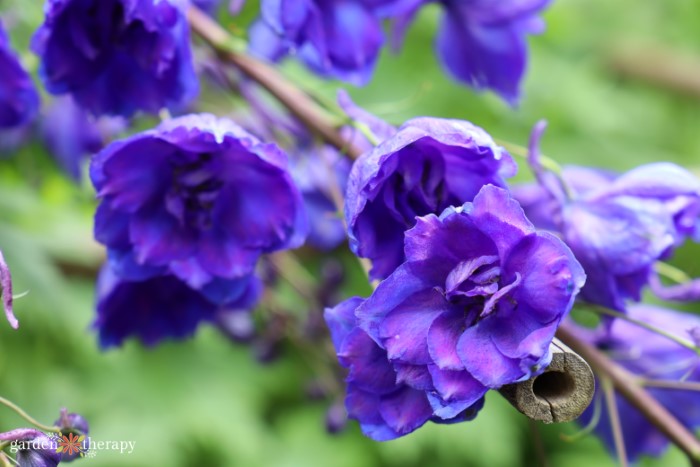

How to Plant Delphinium
As with many perennials, delphinium can be difficult to grow from seed. It’s best to use fresh seed that is less than a year old for best results.
When to Plant
A, early summer blooming flower, you want to plant delphinium in early spring or late fall. You can sow delphinium seeds indoors 8-10 weeks before planting or directly sow them in the ground in early spring (they tend to do better when directly sowed).
Alternatively, you can also sow the seeds in early autumn. They’re very cold-tolerant and can withstand even the coldest winters.
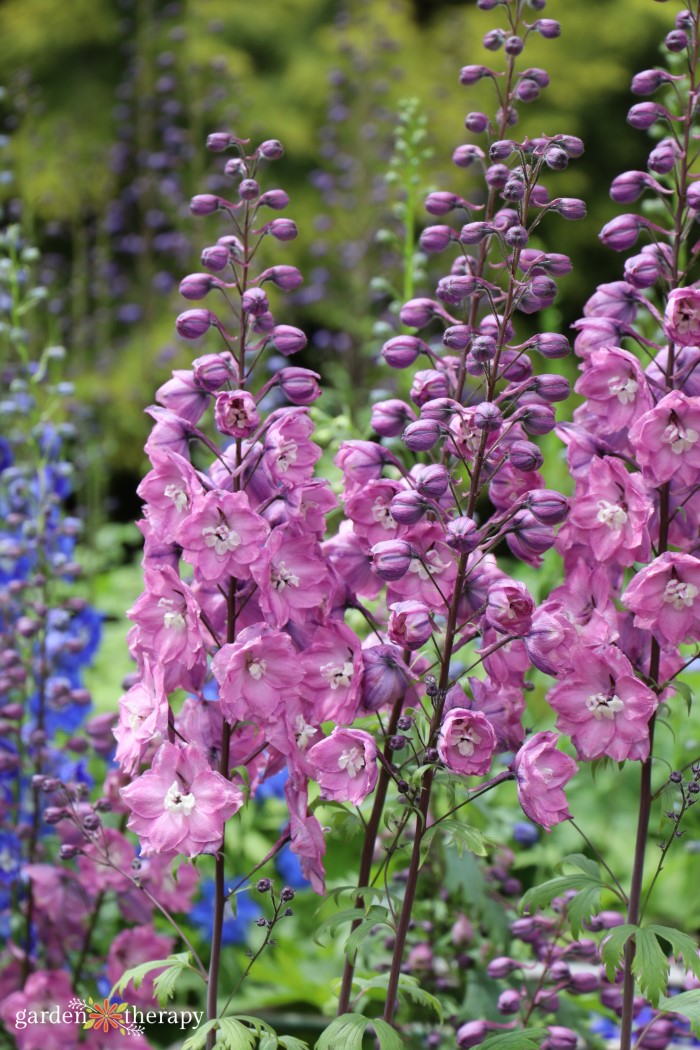

Where to Plant
Delphiniums enjoy cool and moist summers and don’t do well in hot, dry climates. They grow best as perennials in zones 3 to 7.
Sun lovers, delphiniums need a sunny spot in the garden. Provide them with good air circulation and don’t put them in an overcrowded place in the garden. Try to plant them in a sheltered area as strong winds and heavy rain can knock the tall stocks down.
How to Plant
Planting from seed is very easy. Simply sprinkle the tiny seeds and cover them with a thin layer of soil. Space any potted delphiniums 1-3 feet apart. You also want to thin out delphinium seeds after they have sprouted and are about 3 inches high.
For delphiniums returning for the year, thin them out so there 2-3 shoots on young plants and 5-7 on older ones.
Most delphiniums are grown as perennials, so you’ll want to space them accordingly.
All delphiniums, with the exception of dwarf varieties, will need added support such as stakes or cages. Do this in the spring when the plant is about 12 inches high. Otherwise, wind and rain will damage them in one swoop.
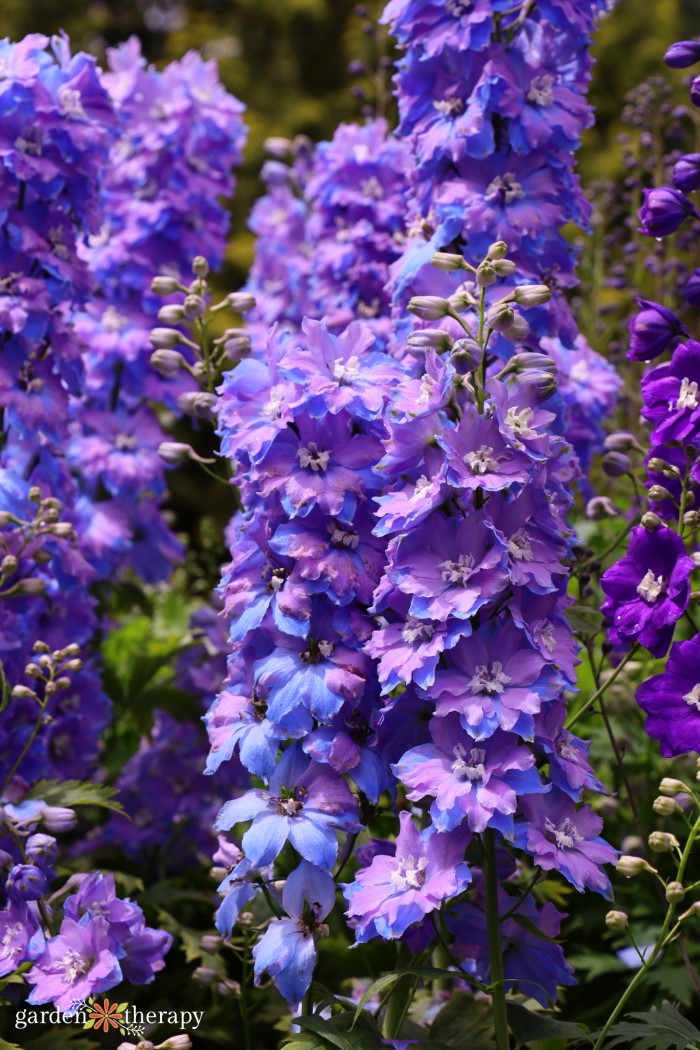

Delphinium Care
Once established, delphiniums are extremely easy to care for. They’re even easier to grow if you buy them as transplants from the nursery! Here’s how to keep them happy.
Light
In order to get the best blooms, plant your delphiniums in a location with full sun. This means they will get half a day of sun, at a minimum of 6 hours a day.
If you live in a hot and dry climate, make sure your delphinium has some afternoon shade. Since they like mild temperatures, they will need some protection.
Water
Delphiniums like a fair amount of water, needing hydration when there is no rain. Water throughout the season, and don’t let them completely dry out. However, don’t let the soil become soggy. Nice and moist is ideal.
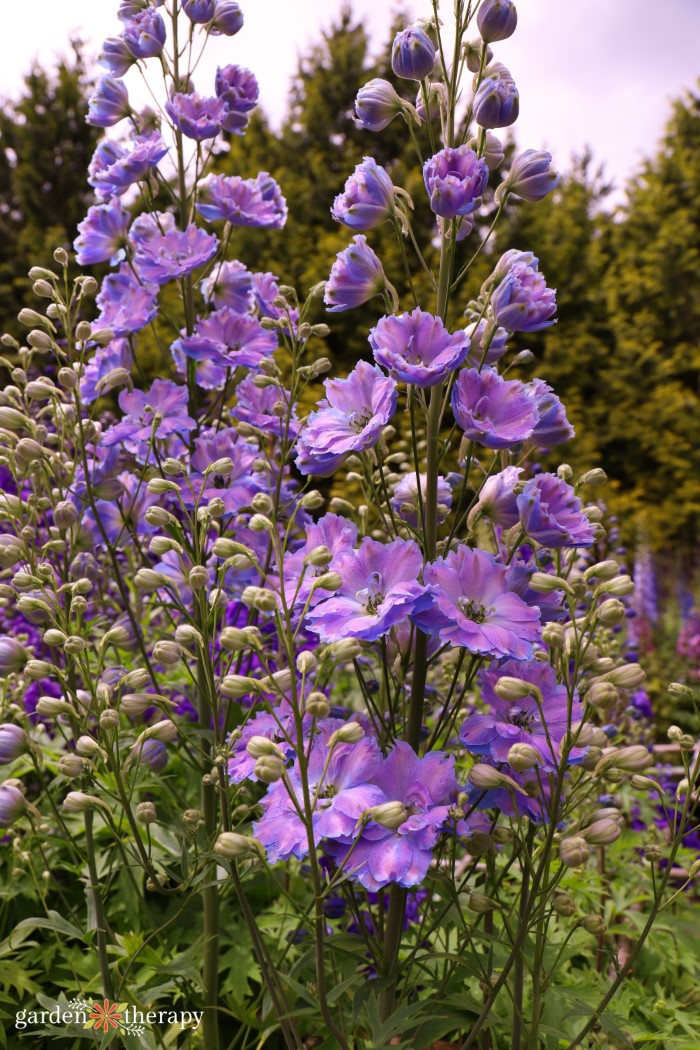

Soil
Most delphinium varieties aren’t too picky about their garden soil. That being said, there’s always an ideal! The goal is to have rich, well-draining soil, that leans towards slightly acidic.
Delphinium can be heavy feeders, so adding lots of organic material upon planting will help you get some beautiful blooms.
Pruning
To encourage a second round of flowers, you will want to deadhead the first round of flowers. Cut the flower spikes back to the small, flowering side shoots.
In the fall, cut back the entire plant to the lowest leaves after it has finished blooming a second time. Leave the remaining foliage to die naturally during the winter.
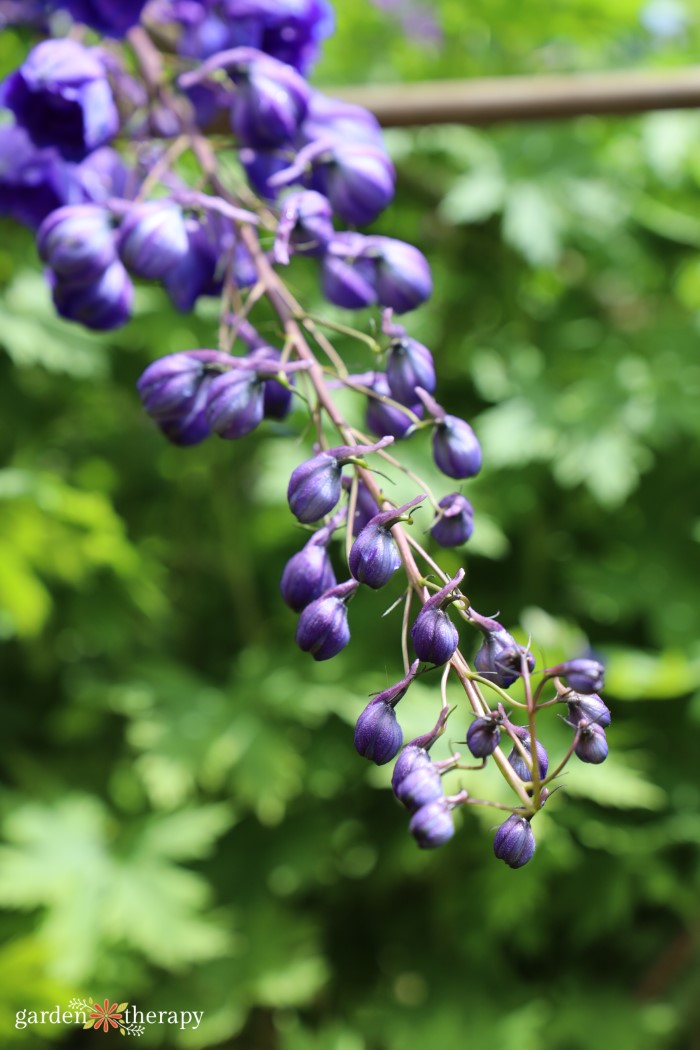

Pests and Diseases
Slugs and snails like delphinium and you may find them lurking on the stalks, especially the young growth.
Another common issue with the plant is powdery mildew. To avoid both powdery mildew and pests, keep the area as clean as possible and free of debris. Avoid having soggy soil and keep good circulation among your plants with proper thinning and pruning.
Dividing
You can multiply your perennial delphinium stash by dividing them. Every 3-4 years during the springtime, remove your delphinium from the ground. You will find the young pieces on the outside. Separate those from the main clump and replant them. Discard the old hard heart.


Cutting Delphinium Flowers
Delphiniums look absolutely gorgeous when you bring them inside. They make for good cutting flowers, adding vibrancy to the home for 6-8 days.
As soon as the delphinium has opened, head out with a bucket of water to place your harvested stalks right after cutting. You want to harvest when one third of the stems have opened, typically on the bottom.
Try to harvest in the morning while it is still cool so the plant isn’t under any stress. Use a sharp, disinfected knife to make clean cuts. Before bringing your stalks inside, check for bugs!
When placing your flowers in a vase, don’t let any of the foliage sit below the water. Add some sugar and vinegar to the water as some homemade floral preservative. Keep them away from ripening fruit, as they are sensitive to ethylene.
Place your flowers out of direct sunlight and change the water every couple of days. Make sure to follow the tips in this post about how to make cut flowers last longer!
And that’s all there is to it! Now you can enjoy their splendour inside or out.
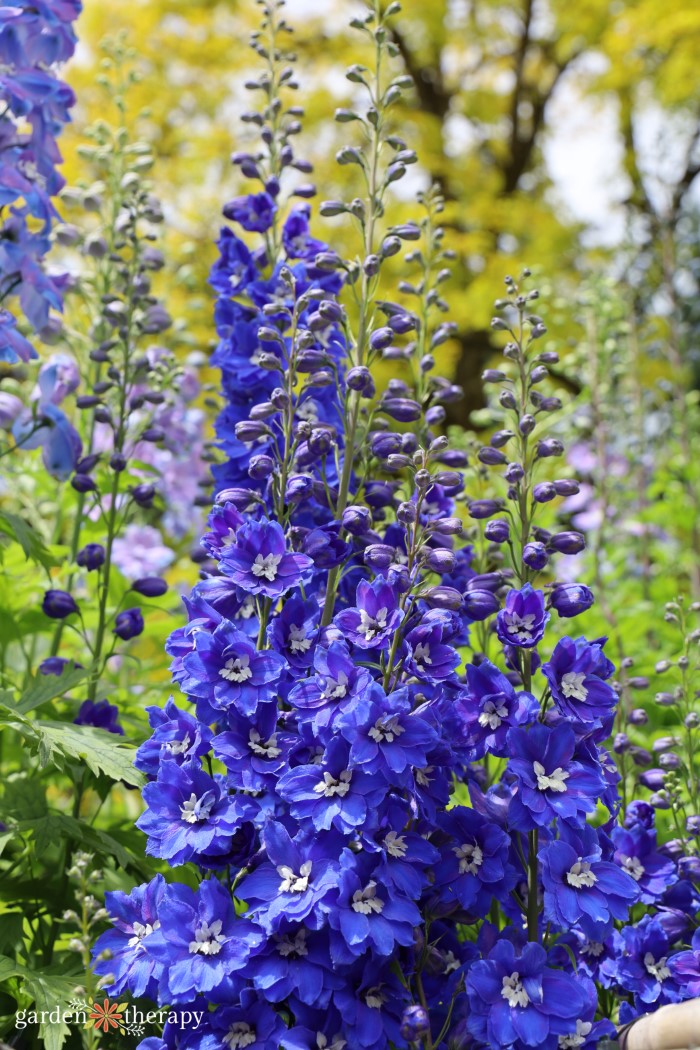

FAQ About Delphinium
Yes! Delphiniums tend to double in size in just their first year. It’s a good idea to divide your delphiniums every three years, typically at the beginning of spring as soon as foliage appears. Remove the entire plant, and then divide it into pieces so each section has roots and foliage. Usually, one large clump can be turned into four.
Yes they can, if they have enough time in the growing season. As soon as the first set of blooms begin to wither, cut down the entire flower stalk. Leave the surrounding foliage. New shoots should emerge within a couple of weeks. This works best for mature delphinium.
Colloquially, many people refer to larkspur as the annual version of delphinium. Meanwhile, delphinium refers to the perennial version.
In reality, the word Delphinium is a genus classification that covers around 300 species of plants. Larkspur can sometimes be used interchangeably at the garden centre, which can make things confusing.
Some people who use the term larkspur are actually referring to the genus Consolida. They do have similar appearances and growth like habit to delphinium, and are part of the same family Ranunculaceae.
More Flowers to Plant:


